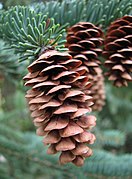Picea glauca
| White spruce | |
|---|---|
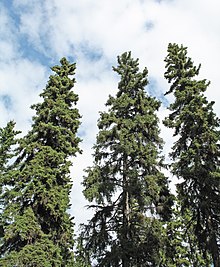
| |
| Mature white spruce in Fairbanks, Alaska | |
| Scientific classification | |
| Kingdom: | Plantae |
| Clade: | Tracheophytes |
| Clade: | Gymnospermae |
| Division: | Pinophyta |
| Class: | Pinopsida |
| Order: | Pinales |
| Family: | Pinaceae |
| Genus: | Picea |
| Species: | P. glauca
|
| Binomial name | |
| Picea glauca (Moench) Voss
| |

| |
| Natural range | |
| Synonyms[3] | |
|
List
| |
| NCBI genome ID | 3330 |
|---|---|
| Ploidy | 2 |
| Genome size | 20 Gbp |
| Number of chromosomes | 12 |
| Year of completion | 2015 |
| Sequenced organelle | plastid and mitochondrion |
| Organelle size | 123 kbp and 5.93 Mbp |
| Year of completion | 2015 |
Picea glauca, the white spruce,[4] is a species of spruce native to the northern temperate and boreal forests in North America. Picea glauca is native from central Alaska all through the east, across western and southern/central Canada to the Avalon Peninsula in Newfoundland, and south to Montana, North Dakota, Minnesota, Wisconsin, Michigan, Upstate New York and Vermont, along with the mountainous and immediate coastal portions of New Hampshire and Maine, where temperatures are just barely cool and moist enough to support it. There is also an isolated population in the Black Hills of South Dakota and Wyoming.[5][6][1][7] It is also known as Canadian spruce, skunk spruce, cat spruce, Black Hills spruce, western white spruce, Alberta white spruce, and Porsild spruce.[8]
Description
[edit]The white spruce is a large evergreen conifer which normally grows to 15 to 30 metres (50 to 100 ft) tall, but can grow up to 40 m (130 ft) tall with a trunk diameter of up to 1 m (3 ft 3 in). The bark is thin and scaly, flaking off in small circular plates 5 to 10 centimetres (2 to 4 in) across. The crown is narrow – conical in young trees, becoming cylindrical in older trees. The shoots are pale buff-brown, glabrous in the east of the range, but often pubescent in the west, and with prominent pulvini. The leaves are needle-like, 12 to 20 millimetres long, rhombic in cross-section, glaucous blue-green above (hence glauca) with several thin lines of stomata, and blue-white below with two broad bands of stomata.[5]
The cones are pendulous, slender, cylindrical, 3 to 7 cm long and 1.5 cm wide when closed, opening to 2.5 cm broad. They have thin, flexible scales 15 mm long with a smoothly rounded margin. They are green or reddish, maturing to pale brown 4 to 8 months after pollination. The seeds are black, 2 to 3 mm long, with a slender, 5 to 8 mm long pale brown wing.[5]
-
Young tree
-
Mature tree
-
Mature tree that has lost its lower branches
-
The bark is thin and scaly, flaking off in small circular plates
-
Twig with striped, blue-green, four-sided needles
-
Mature female cone
-
Female cone
-
Young female cone
-
Male cone and pollen
Seeds
[edit]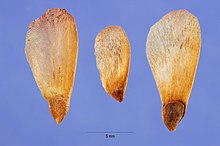
Seeds are small, 2.5 to 5 mm long, oblong, and acute at the base. Determinations of the average number of sound seeds per white spruce cone have ranged from 32 to 130.[9][10]
Common causes of empty seed are lack of pollination, abortion of the ovule, and insect damage.
The average weight per individual seed varies from 1.1 mg to 3.2 mg.[11]
Each seed is clasped by a thin wing 2 to 4 times as long as the seed. Seed and wing are appressed to the cone scale. Embryo and megagametophyte are soft and translucent at first; later the endosperm becomes firm and milky white, while the embryo becomes cream-coloured or light yellow. At maturity, the testa darkens rapidly from light brown to dark brown or black.[12] Mature seeds "snaps in two" when cut by a sharp knife on a firm surface.[12]
White spruce cones reach their maximum size after 800 GDD. Cone moisture content decreases gradually after about 1000 GDD.[13]
Cone colour also can be used to help determine the degree of maturation, but cones may be red, pink or green.[14] Collection and storage dates and conditions influence germination requirements and early seedling growth.[15][16][17]
A bushel (35 L) of cones, which may contain 6500 to 8000 cones, yields 6 to 20 ounces (170 to 570 g) of clean seed.[18]
Seed dispersal begins after cone scales reflex with cone maturation in the late summer or early fall of the year of formation. Cones open at moisture contents of 45% to 70% and specific gravities of 0.6 to 0.8.[13][15][17] Weather affects both the initiation and pattern of seed dispersal, but cone opening and the pattern of seed dispersal can vary among trees in the same stand.[8] Even after dispersal has begun, cold, damp weather will cause cone scales to close; they will reopen during dry weather. Most seed falls early rather than late, but dispersal may continue through fall and winter and even into the next growing season.[19][20] Seed dispersal occurs mainly in late summer or early fall.[9]
White spruce seed is initially dispersed through the air by wind. Both the initiation and pattern of seed dispersal depend on the weather,[8] but these can vary among trees in the same stand.[19] Small amounts of white spruce seed are normally dispersed beyond 100 m from the seed source, but exceptionally seeds have been found more than 300–400 m from the nearest seed source.[19]
Root system
[edit]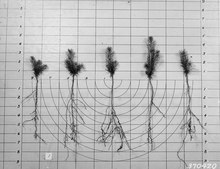
The root system of white spruce is highly variable and adaptable, responding to a variety of edaphic factors, especially soil moisture, soil fertility, and mechanical impedance.[21][22] On soils that limit rooting depth, the root system is plate-like, but it is a common misconception to assume that white spruce is genetically constrained to develop plate-like root systems irrespective of soil conditions.[23] In the nursery, or naturally in the forest, white spruce usually develops several long 'running' roots just below the ground surface.[24]
The structure of the tracheids in the long lateral roots of white spruce varies with soil nitrogen availability.[25]
Stem
[edit]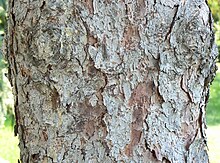
White spruce can live for several hundred years, with an estimated average lifespan of 250 to 300 years.[26]
Slow-growing trees in rigorous climates are also capable of great longevity. White spruce 6 to 10 m (20 to 33 ft) high on the shore of Urquhart Lake, Northwest Territories, were found to be more than 300 years old.[27]
Bark
[edit]The bark of mature white spruce is scaly or flaky, grey-brown or ash-brown, but silvery when freshly exposed.[28][29] Resin blisters are normally lacking, but the Porsild spruce Picea glauca var. porsildii Raup has been credited with having smooth resin-blistered bark.[30]
White spruce bark is mostly less than 8 mm and not more than 9.5 mm thick.[31][32]
Chemistry
[edit]Isorhapontin can be found in spruce species such as the white spruce.[33]
P. glauca has three different genomes; a nuclear genome,[34] a mitochondrial genome,[35] and a plastid (i.e. chloroplast) genome.[36] The large (20 Gbp) nuclear genome of P. glauca (genotype WS77111) was published in 2015,[37] and the organellar (plastid and mitochondrial) genomes (genotype PG29) were published in SD Jackman et al. 2015.[38] The plastid genome of P. glauca (genotype WS77111) has also been published.[39]
Varieties
[edit]
Several geographical varieties have been described, but are not accepted as distinct by all authors. These comprise, from east to west:[5]
- Picea glauca var. glauca (typical or eastern white spruce): from Newfoundland west to eastern Alberta, on lowland plains.
- Picea glauca var. densata (Black Hills white spruce): The Black Hills in South Dakota.
- Picea glauca var. albertiana (Alberta white spruce): The Rocky Mountains in Alberta, British Columbia and northwest Montana.
- Picea glauca var. porsildii (Alaska white spruce): Alaska and Yukon.
The two western varieties are distinguished by pubescent shoots, and may be related to extensive hybridisation and intergradation with the closely related Engelmann spruce found further south in the Rocky Mountains. White spruce also hybridises readily with the closely related Sitka spruce where they meet in southern Alaska and northwestern British Columbia; this hybrid is known as Picea × lutzii.[5]
Distribution and habitat
[edit]
White spruce has a transcontinental range in North America. In Canada, its contiguous distribution encompasses virtually the whole of the Boreal, Subalpine, Montane, Columbia, Great Lakes–St. Lawrence, and Acadian Forest Regions, extending into every province and territory.[40][41] On the west coast of Hudson Bay, it extends to Seal River, about 59°N, "from which the northward limit runs apparently almost directly north-west to near the mouth of the Mackenzie River, or about latitude 68°".[42] Collins and Sumner[43] reported finding white spruce within 13 km of the Arctic coast in the Firth Valley, Yukon, at about 69°30′ N, 139°30′ W. It reaches within 100 km of the Pacific Ocean in the Skeena Valley, overlapping with the range of Sitka spruce (Picea sitchensis), and almost reaching the Arctic Ocean at latitude 69° N in the District of Mackenzie, with white spruce up to 15 m high occurring on some of the islands in the Delta near Inuvik.[44] The wide variety of ecological conditions in which 4 Quebec conifers, including white spruce, are able to establish themselves, was noted by Lafond,[45] but white spruce was more exacting than black spruce. In the United States, the range of white spruce extends into Maine, Vermont, New Hampshire, New York, Michigan, Wisconsin, Minnesota, and Alaska,[29][46] where it reaches the Bering Strait in 66°44′ N" at Norton Bay and the Gulf of Alaska at Cook Inlet.[8]
Southern outliers have been reported in southern Saskatchewan and the Cypress Hills of southwestern Saskatchewan[8][47] and southeastern Alberta,[48] northwestern Montana,[29] south-central Montana, in the Black Hills on the Wyoming–South Dakota boundary, on the Manitoba–North Dakota boundary, and at Shushan, New York.[49][50][51]
White spruce is the northernmost tree species in North America, reaching just north of 69°N latitude in the Mackenzie River delta.[52] It grows between sea level and an elevation of 1,520 m (4,990 ft). Its northern distribution roughly correlates to the location of the tree line, which includes an isothermic value of 10 °C (50 °F) for mean temperature in July, as well as the position of the Arctic front; cumulative summer degree days, mean net radiation, and the amount of light intensities also figure. White spruce is generally found in regions where the growing season exceeds 60 days annually.[8]
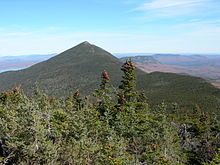
The southern edge of the zone in which white spruce forms 60% or more of the total stand corresponds more or less to the July isotherm of 18 °C (64 °F) around the Great Lakes; in the Prairie Provinces its limit is north of this isotherm. During the summer solstice, day length values range from 17 hours at its southern limits to 24 hours above the Arctic Circle.[8]
One of the hardiest conifers, white spruce in parts of its range withstands mean daily January temperature of −6.7 °C (19.9 °F) and extreme minimum temperatures as low as −56.5 °C (−69.7 °F); minimum temperatures of −50 °C (−58 °F) are general throughout much of the range except the southernmost and southeasternmost parts.[53] By itself, or with black spruce and tamarack (Larix laricina), white spruce forms the northern boundary of tree-form growth.[54] White spruce up to 15 m in height occur at 69°N on islands in the Mackenzie Delta near Inuvik in the Northwest Territories. Hustich (1966)[55] depicted Picea spp. as forming the northernmost limit of tree growth in North America.
The arctic or northern timberline in North America forms a broad transition zone from Labrador to northern Alaska. In Labrador, white spruce is not abundant and constitutes less than 5% of the forest, with a range that coincides very closely with that of black spruce but extending slightly further north.[56]
The range of white spruce extends westwards from Newfoundland and Labrador, and along the northern limit of trees to Hudson Bay, Northwest Territories, Yukon, and into northwestern Alaska.[53] Across western Canada and Alaska, white spruce occurs further north than black spruce, and, while poplar (Populus), willow, and birch may occur along streams well into the tundra beyond the limits of spruce, the hardwoods are usually no more than scrub.[57] Spruce characteristically occurs in fingers of tree-form forest, extending far down the northern rivers and as scattered clumps of dwarfed "bush" spruce on intervening lands.[49][58] In Manitoba, Scoggan[47] noted that the northernmost collection of white spruce was at latitude 59°48’N, but Bryson et al.[59] found white spruce in the northern edge of continuous forest in central Canada at Ennadai Lake, about 60°45′ N, 101°’W, just north of the northwest corner of Manitoba. Bryson et al.[59] noted that the forest retained "the same general characteristics as when it was first described [by Tyrrell[60]] in 1896". Collins and Sumner[43] reported finding white spruce within 13 km of the Arctic coast in the Firth valley, Yukon, at about 69°30′ N, 139°30′ W, and Sargent[46] noted that white spruce in Alaska "reached Behring Strait in 66°44′ N".

Climate, especially temperature, is obviously a factor in determining distributions of northern flora. Halliday and Brown[58] suggested that white spruce's northern limit corresponds "very closely" with the July mean monthly isotherm of 10 °C in Ungava, but that the northern limit west of Hudson Bay was south of that isotherm. Other climatic factors that have been suggested as affecting the northern limit of white spruce include: cumulative summer degree days, position of the Arctic front in July, mean net radiation especially during the growing season, and low light intensities.[8] Topography, soil conditions, and glaciation may also be important in controlling northern limits of spruce.[61]
The southern limit of distribution of white spruce is more complex. From east of the main range of coastal mountains in British Columbia, the southern continuous limit of white spruce is the forest/prairie interface through Alberta, Saskatchewan, Manitoba, the northern parts of Minnesota and Wisconsin, central Michigan, northeastern New York, and Maine.[53] Sargent[46] and Harlow and Harrar[29] also included Vermont and New Hampshire; and, while Dame and Brooks[62] excluded New York and states further west, they included Massachusetts as far south as Amherst and Northampton, "probably the southern limit of the species" in that area. Nisbet[63] gave the range of white spruce as extending to "Carolina", but he did not recognize red spruce as a species and presumably included it with white spruce.
Towards the southern parts of its range, white spruce encounters increasingly effective ecological competition from hardwoods, some of which may reinforce their growth-rate or sprouting competitiveness with allelopathic depredation of coniferous regeneration.[64] Further southward extension of the distribution is inhibited by white spruce's cold requirement.
As an exotic species
[edit]As an exotic, white spruce is widespread but uncommon. It was introduced into England[65] and parts of continental Europe[63][66] in or soon after the year 1700, into Denmark about 1790,[67] and into Tasmania and Ceylon shortly before 1932.[68]
Nisbet[63] noted that firmly-rooted white spruce served very well to stabilize windswept edges of woods in Germany. In a narrow belt of mixed Norway and white spruces over an extremely exposed hilltop crest at high elevation in northern England, the Norway spruce were "completely dwarfed" whereas the white spruce had reached heights of between 3 and 4.3 m.[69] The age of the belt was not recorded, but adjoining 66-year-old stands may have been of the same vintage.
White spruce has also been used as a minor plantation species in England and Scotland.[70][71][72] In Scotland, at Corrour, Inverness-shire, Sir John Stirling Maxwell in 1907 began using white spruce in his pioneering plantations at high elevations on deep peat. However, plantations in Britain have generally been unsatisfactory,[73] mainly because of damage by spring frosts after mild weather had induced flushing earlier in the season. However, the species is held in high regard in the Belgian peat region, where it grows better than do the other spruces.[74]
Ecology
[edit]
White spruce is a climax canopy tree in the boreal forests of Canada and Alaska. It generally occurs on well-drained soils in alluvial and riparian zones, although it also occurs in soils of glacial and lacustrine origin.[8] The understory is dominated by feather mosses (Hylocomium splendens, Pleurozium schreberi, Ptilium crista-castrensis) and fork mosses, and occasionally peat moss.[75] In the far north, the total depth of the moss and underlying humus is normally between 25 and 46 cm (10 and 18 in), although it tends to be shallower when hardwoods are present in the stand.[8]
White spruce grows in soils with pH values of 4.7–7.0, although they have been found in soils as acidic as 4.0 in subalpine fir forests in the Northwest Territories. A presence of calcium in the soil is common to white spruce found in northern New York. White spruce most commonly grows in the soil orders of Alfisols and Inceptisols. Soil properties such as fertility, temperature, and structural stability are partial determinants of the ability of white spruce to grow in the extreme northern latitudes.[8] In the northern limits of its range, white spruce is the climax species along with black spruce; birch and aspen are the early succession species.[75] Wildfires typically occur every 60 to 200 years, although they have been known to occur as infrequently as every 300 years.[75]
White spruce will grow in USDA Growing Zones 3–7, but is not adapted to heat and humidity and will perform poorly in a hot climate.[citation needed] The tree attains its greatest longevity and growth potential in Zones 3–4.
Wildlife such as deer, rabbits, and grouse browse the foliage during the winter.[76]
Soils
[edit]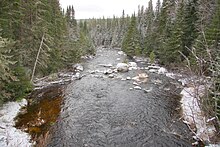
White spruce occurs on a wide variety of soils, including soils of glacial, lacustrine, marine, and alluvial origins; overlying basic dolomites, limestones and acidic Precambrian and Devonian granites and gneisses; and Silurian sedimentary schists, shales, slates, and conglomerates.[77] The wide range of textures accommodated includes clays, even those that are massive when wet and columnar when dry, sand flats, and coarse soils.[40][78][79][80][81] Its occurrence on some organic soils is not characteristic, except perhaps on shallow mesic organic soils in Saskatchewan and in association with black spruce on organic soils in central Yukon.[8]
Podzolized, brunisolic, luvisolic, gleysolic, and regosolic (immature) soils are typical of those supporting white spruce throughout the range of the species.[80] Soils supporting white spruce are most commonly Alfisols or Inceptisols.[8] In the podzol region of Wisconsin, white spruce occurs on loam podzols, podzolized gley loams, strongly podzolized clays, gley-podzol clays, stream-bottom soils, and wood peat.[78] Moist sandy loams also support good growth.[29] On sandy podzols,[78] it is usually a minor species.[8] Good development occurs on moist alluvium on the banks of streams and borders of swamps.[80][82][83][84][85][40][86][87] White spruce makes good growth on well-drained lacustrine soils in Alberta Mixedwoods,[88] on moderately-well-drained clay loams in Saskatchewan,,[89] and on melanized loams and clays (with sparse litter and a dark-coloured organically-enriched mineral horizon) in the Algoma district of Ontario.[79]
White spruce becomes less accommodating of soil with increasing severity of climate. The distribution of white spruce in Labrador seems to depend almost entirely on the character of the soil,[86] and between the southwestern shores of Hudson Bay and the northeastern regions of Saskatchewan, white spruce is confined to very local physiographic features, characterized by well-drained or fertile soils.[90]
On dry, deep, outwash deposits in northern Ontario, both white spruce and aspen grow slowly.[91] But, broadly, white spruce is able to tolerate considerable droughtiness of sites that are fertile, and no fertile site is too moist unless soil moisture is stagnant.[92] Soil fertility holds the key not just to white spruce growth but to the distribution of the species. At least moderate fertility is needed for good growth, but white spruce occurs on many sites where nutrient deficiencies depress its growth more than that of black spruce, red spruce, Norway spruce, and the pines generally.[93] Minimum soil-fertility standards recommended for white spruce sufficient to produce 126 to 157 m3/ha of wood at 40 years are much higher than for pine species commonly planted in the Lake States (Wilde 1966):[94] 3.5% organic matter, 12.0 meq/100 g exchange capacity, 0.12% total N, 44.8 kg/ha available P, 145.7 kg/ha available K, 3.00 meq/100 g exchangeable Ca, and 0.70 meq/100 g exchangeable Mg.
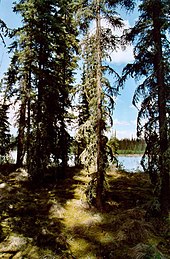
Forest floors under stands dominated by white spruce respond in ways that vary with site conditions, including the disturbance history of the site.[8] Composition, biomass, and mineral soil physical and chemical properties are affected. In Alaska, the accumulation of organic layers (to greater thicknesses in mature stands of spruce than those in hardwood stands on similar sites) leads to decreased soil temperatures, in some cases leading to the development of permafrost.[95][96][97] Acidity of the mineral soil sampled at an average depth of 17 cm in 13 white spruce stands on abandoned farmland in Ontario increased by 1.2 pH units over a period of 46 years.[98]
A considerable range of soil pH is tolerated by white spruce.[80] Thrifty stands of white spruce in Manitoba have developed on soils of pH 7.6 at only 10 cm below the surface, and pH 8.4 at 43 cm below the surface;[99][100] rooting depth in those soils was at least 81 cm. An abundant calcium supply is common to most white spruce locations in New York state.[8] Chlorosis was observed in young white spruce in heavily limed nursery soils at about pH 8.3.[80] Wilde[94] gave 4.7 to 6.5 as the approximate optimum range of pH for white spruce in Wisconsin, but optimum growth seems possible at pH levels up to 7.0 and perhaps higher.[92] Alluvium on the floodplains of northern rivers shows pH levels from 5.0 to 8.2.[101] High-lime ecotypes may exist,[102] and in Canada Forest Section B8 the presence of balsam poplar and white spruce on some of the moulded moraines and clays seems to be correlated with the considerable lime content of these materials,[40][103] while calcareous soils are favourable sites for northern outliers of white spruce.[57]
Mature stands of white spruce in boreal regions often have well-developed moss layers dominated by feather mosses, e.g., Hylocomium splendens, Pleurozium schreberi, Ptlium crista-castrensis, and Dicranum, rather than Sphagnum.[104][105] The thickness of the moss–organic layer commonly exceeds 25 cm in the far north and may approach twice that figure. The mosses compete for nutrients and have a major influence on soil temperatures in the rooting zone. Permafrost development in parts of Alaska, Yukon, and the Northwest Territories is facilitated by the insulative organic layer (Viereck 1970a, b, Gill 1975, Van Cleve and Yarie 1986).[95][96][106][107]
Cold hardiness
[edit]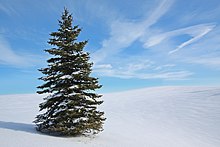
White spruce is extremely hardy to low temperatures, provided the plant is in a state of winter dormancy. Throughout the greater part of its range, white spruce routinely survives and is undamaged by winter temperatures of −50 °C (−58 °F), and even lower temperatures occur in parts of the range.[8][53] Boreal Picea are among the few extremely hardy conifers in which the bud primordia are able to survive temperatures down to −70 °C, −94 °F.[108]
Especially important in determining the response of white spruce to low temperatures is the physiological state of the various tissues, notably the degree of "hardening" or dormancy. A natural progression of hardening and dehardening occurs in concert with the seasons.[109] While different tissues vary in ability to tolerate exposure to stressful temperatures, white spruce, as with woody plants in general, has necessarily developed sufficient winter hardiness in its various tissues to enable them to survive the minimum temperatures experienced in the distribution range.
White spruce is subject to severe damage from spring frosts. Newly flushed shoots of white spruce are very sensitive to spring frost.[110][111][112] This sensitivity is a major constraint affecting young trees planted without overstorey nurses in boreal climates.[113]
Forest succession
[edit]
Forest succession in its traditional sense implies two important features that resist direct examination.[114] First, classical definitions generally connote directional changes in species composition and community structure through time, yet the time frame needed for documentation of change far exceeds an average human lifespan.[114] The second feature that defies quantitative description is the end point or climax.
Floodplain deposits in the Northwest Territory, Canada, are important in relation to the development of productive forest types with a component of white spruce.[83] The most recently exposed surfaces are occupied by sandbar vegetation or riparian shrub willows and Alnus incana. With increasing elevation, the shrubs give way successively to balsam poplar and white spruce forest. In contrast, older floodplains, with predominantly brown wooded soils, typically carry white spruce–trembling aspen mixedwood forest.
Interrelationships among nutrient cycling, regeneration, and subsequent forest development on floodplains in interior Alaska were addressed by Van Cleve et al.,[115] who pointed out that the various stages in primary succession reflect physical, chemical, and biological controls of ecosystem structure and function. Thus, each successional stage has a species combination in harmony with site quality. Short-circuiting succession by planting a late successional species such as white spruce on an early successional surface may result in markedly reduced growth rates because of nitrogen insufficiency. Without application of substantial amounts of fertilizer, use would have to be made of early successional alder and its site-ameliorating additions of nitrogen.
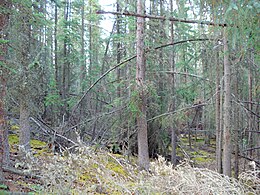
Neiland and Viereck noted that “the slow establishment and growth of spruce under birch stands [in Alaska] may be partially due to effects of shading and general competition for water and nutrients, but may also be more directly related to the birch itself. Heikinheimo[116][117] found that birch ash inhibited white spruce seedlings, and Gregory[118] found that birch litter has a smothering effect on spruce seedlings.".[119]
On dry upland sites, especially south-facing slopes, the mature vegetation is white spruce, white birch, trembling aspen, or a combination of these species. Succession follows in one of two general patterns. In most cases, aspen and birch develop as a successional stage after fire before reaching the spruce stage. But, occasionally, with optimal site conditions and a source of seed, white spruce will invade with the hardwoods or within a few years thereafter, thereby producing even-aged white spruce stands without an intervening hardwood stage.
Associated forest cover
[edit]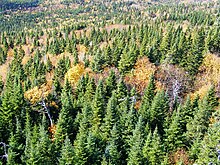
The White Spruce Cover Type may include other species in small numbers. In Alaska, associates include paper birch, trembling aspen, balsam poplar, and black spruce; in western Canada, additional associates are subalpine fir, balsam fir, Douglas-fir, jack pine, and lodgepole pine.[120] Seral species giving way to white spruce include paper birch, aspen, balsam poplar, jack pine, and lodgepole pine. On certain river bottom sites, however, black spruce may replace white spruce.[120] Earlier successional stages leading to the white spruce climax are the white spruce–paper birch, white spruce–aspen, balsam poplar, jack pine, and lodgepole pine types. The type shows little variation. The forest is generally closed and the trees well formed, other than those close to the timberline. Lesser vegetation in mature stands is dominated by mosses. Vascular plants are typically few, but shrubs and herbs that occur “with a degree of regularity” include: alder, willows, mountain cranberry, red-fruit bearberry, black crowberry, prickly rose, currant, buffaloberry, blueberry species, bunchberry, twinflower, tall lungwort, northern comandra, horsetail, bluejoint grass, sedge species, as well as ground-dwelling mosses and lichens. Several white spruce communities have been identified in interior Alaska: white spruce/feathermoss; white spruce/dwarf birch/feathermoss; white spruce/dwarf birch/sphagnum; white spruce/avens/moss; and white spruce/alder/bluejoint.[121][120]
Of the Eastern Forest Cover Types recognized by the Society of American Foresters,[122] only one, White Spruce, names that species in its title. The eastern White Spruce Cover Type, as defined, encompasses white spruce both in pure stands, and in mixed stands "in which white spruce is the major [undefined] component."[123]
In most of its range, white spruce occurs more typically in association with trees of other species than in pure stands.
White spruce is an associated species in the following Eastern Forest cover types, by the Society of American Foresters; in the Boreal Forest Region: (1) jack pine, (5) balsam fir, (12) black spruce, (16) aspen, (18) paper birch, and (38) tamarack; in the Northern Forest Region: (15) red pine, (21) eastern white pine, (24) hemlock-yellow birch, (25) sugar maple-beech-yellow birch, (27) sugar maple, (30) red spruce-yellow birch, (32) red spruce, (33) red spruce-balsam fir, (37) northern white-cedar, and (39) black ash-American elm-red maple.[8][122]
Predators
[edit]
Outbreaks of spruce beetles have destroyed over 2,300,000 acres (9,300 km2) of forests in Alaska.[124]
Although sometimes described, e.g., by Switzer (1960),[125] as relatively resistant to attack by insects and disease, white spruce is far from immune to depredation. Important insect pests of white spruce include the spruce budworm (Choristoneura fumiferana), the yellow-headed spruce sawfly (Pikonema alaskensis), the European spruce sawfly (Gilpinia hercyniae), the spruce bud moth (Zeiraphera canadensis),[126] and spruce beetle (Dendroctonus rufipennis).[127][126][128] As well, other budworms, sawflies, and bark beetles, gall formers, bud midges, leaf miners, aphids, leaf eaters, leaf rollers, loopers, mites, scales, weevils, borers, pitch moths, and spittlebugs cause varying degrees of damage to white spruce.[128]
A number of sawflies feed on spruce trees. Among them European spruce sawfly, yellow-headed spruce sawfly, green-headed spruce sawfly and the spruce webspinning sawfly.[126]
More than a dozen kinds of looper feed on the spruces, fir, and hemlock in eastern Canada. The full-grown larvae of the larvae vary in length from 15 mm to 35 mm. Some feed briefly in the fall and complete their feeding in the spring; others feed mainly in the summer; still others feed mainly in the late summer and fall.
The fall and spring feeding group includes the dash-lined looper (Protoboarmia porcelaria indicataria), the diamond-backed looper (Hypagyrtis piniata), the fringed looper (Campaea perlata), and the false loopers (Syngrapha species). The summer feeding group includes the false hemlock looper (Nepytia canosaria Walker), occasionally occurring in large numbers and usually in conjunction with the hemlock looper (Lambdina fiscellaria), the Eupithecia species, the yellowlined conifer looper (Cladara limitaria), and the saddleback looper (Ectropis crepuscularia).
The late summer and fall group includes the common spruce-fir looper (Semiothisa signaria dispuncta) and the similar hemlock angle (moth) Macaria fissinotata on hemlock, the small spruce loopers Eupithecia species, the gray spruce looper Caripeta divisata, occasionally abundant, the black-dashed hydriomena moth (Hydriomena divisaria), and the whitelined looper (Eufidonia notataria).
Cultivars
[edit]
Numerous cultivars of various sizes, colours and shapes have been selected for use in parks and gardens. The following have gained the Royal Horticultural Society's Award of Garden Merit.[129]
- Picea glauca ‘Echiniformis’[130]
- Picea glauca var. albertiana ‘Alberta Globe’[131]
- Picea glauca var. albertiana ‘Conica’[132]
'Conica' is a dwarf conifer with very slender leaves, like those normally found only on one-year-old seedlings, and very slow growth, typically only 2–10 cm (3⁄4–4 in) per year. Older specimens commonly 'revert', developing normal adult foliage and starting to grow much faster; this 'reverted' growth must be pruned if the plant is to be kept dwarf.
Uses
[edit]
The wood of white spruce is of a lower quality than that of Engelmann spruce, but is stronger. It was used to make shelters and as firewood by Native Americans and European settlers in Alaska, where lodgepole pine does not grow.[133] The wood is of major economic importance in Canada, being harvested for paper and construction. It is also used as a Christmas tree.
The wood is also exported to Japan where, known as "shin-kaya", it is used to make go boards as a substitute for the rare kaya wood.
Black Hills spruce (Picea glauca var. densata) is used for bonsai.
White spruce is the provincial tree of Manitoba[134] and the state tree of South Dakota.
The new growth or tips of white spruce is used in beer making,[135] gin production,[136] flavouring pop,[137] candy making or in pickles and preserves. [138]
References
[edit]- ^ a b Farjon, A. (2013). "Picea glauca". IUCN Red List of Threatened Species. 2013: e.T42323A2972485. doi:10.2305/IUCN.UK.2013-1.RLTS.T42323A2972485.en. Retrieved 12 November 2021.
- ^ NatureServe (2024). "Picea glauca". Arlington, Virginia. Retrieved 7 September 2024.
- ^ "Picea glauca". World Checklist of Selected Plant Families. Royal Botanic Gardens, Kew – via The Plant List. Note that this website has been superseded by World Flora Online
- ^ USDA, NRCS (n.d.). "Picea glauca". The PLANTS Database (plants.usda.gov). Greensboro, North Carolina: National Plant Data Team. Retrieved 2 October 2015.
- ^ a b c d e Farjon, A. (1990). Pinaceae. Drawings and Descriptions of the Genera. Koeltz Scientific Books. ISBN 3-87429-298-3.
- ^ Rushforth, K. (1987). Conifers. Helm. ISBN 0-7470-2801-X.
- ^ Earle, Christopher J., ed. (2018). "Picea glauca". The Gymnosperm Database.
- ^ a b c d e f g h i j k l m n o p q r Nienstaedt, Hans; Zasada, John C. (1990). "Picea glauca". In Burns, Russell M.; Honkala, Barbara H. (eds.). Conifers. Silvics of North America. Vol. 1. Washington, D.C.: United States Forest Service (USFS), United States Department of Agriculture (USDA). Retrieved 14 November 2010 – via Southern Research Station.
- ^ a b Waldron, R.M. (1965). "Cone production and seedfall in a mature white spruce stand". The Forestry Chronicle. 41 (3): 314–329. doi:10.5558/tfc41316-3.
- ^ Zasada, J.C.; Viereck, L.A. 1970. White spruce cone and seed production in interior Alaska, 1957–68. USDA, For. Serv., Pacific NW For. Range Exp. Sta., Portland OR, Res. Note PNW-129. 11 p. [Coates et al. 1994]
- ^ Hellum, A.K. 1976. Grading seed by weight in white spruce. USDA, For. Serv., Tree Plant. Notes 27(1):16–17, 23–24. (Cited in Coates et al. 1994).
- Zasada, J.C.; Foote, M.J.; Deneke, F.J.; Parkerson, R.H. 1978. Case history of an excellent white spruce cone and seed crop in interior Alaska: cone and seed production, germination and seedling survival. USDA, For. Serv., Pacific NW For. Range Exp. Sta., Portland OR, Gen. Tech. Rep. PNW-65. 53 p. - ^ a b Crossley, D.I. 1953. Seed maturity in white spruce. Canada Dep. Resour. and Devel., For. Branch, For. Res. Div., Ottawa ON, Silv. Res. Note 104. 16 p.
- ^ a b Cram, W.H.; Worden, H.A. 1957. Maturity of white spruce cones and seed. For. Sci. 3:263–269.
- ^ Teich, A.H. 1970. Genetic control of female flower colour and random mating in white spruce. Can. Dep. Fish. For., Can. For. Serv., Ottawa ON, Bi-mo. Res. Notes 26:2.
- ^ a b Zasada, J.C. 1973. Effect of cone storage method and collection date on Alaskan white spruce (Picea glauca) seed quality. p. 1–10 (paper 19) in Proc. Seed Problems. IUFRO Symp. Seed Processing, Bergen, Norway. Working Party S2.01, Royal Coll. For., Bergen, Norway, Vol. 1. [Coates et al. 1994]
- ^ Edwards, I.K. 1977. Fertility of transplant fields at the Prince Albert Forest Nursery. Can. Dep. Fish. Environ., Can. For. Serv., Northern For. Res. Centre, Edmonton AB, Inf. Rep. NOR-X-189. 21 p.
- ^ a b Winston, D.A.; Haddon, B.D. 1981. Effects of early cone collection and artificial ripening on white spruce and red pine germination. Can. J. For. Res. 11:817–826.
- ^ USDA Forest Service. 1948. Woody-plant Seed Manual. USDA, For. Serv., Washington DC, Misc. Publ. 654. 416 p.
- ^ a b c Zasada, J. 1986. Natural regeneration of trees and tall shrubs on forest sites in interior Alaska. p. 44–73 in Van Cleve, K.; Chapin, F.S.; Flanagan, P.W.; Viereck, L.A.; Dyrness, C.T. (Eds.). Forest Ecosystems in the Alaskan Taiga: a Synthesis of Structure and Function. Springer-Verlag New York NY.
- ^ Rowe, J.S. 1953. Viable seed on white spruce trees in midsummer. Can. Dep. Northern Affairs and National Resources, For. Branch, For. Res. Div., Ottawa ON, Silv. Leafl. 99. 2 p.
- ^ Wagg, J.W.G. 1964. White spruce regeneration on the Peace and Slave River lowlands. Can. Dep. For., For. Res. Branch, Ottawa ON, Publ. 1069. 35 p.
- ^ Wagg, J.W.B. 1967. Origin and development of white spruce root-forms. Can. Dep. For. Rural Devel., For. Branch, Ottawa ON, Publ. 1192. 45 p.
- ^ Sutton, R.F. 1969. Form and development of conifer root systems. Commonw. For. Bureau, Oxford, U.K., Tech. Communication No. 7. 131 p.
- ^ Mullin, R.E. 1957. Experiments with root and top pruning of white spruce nursery stock. Ont. Dep. Lands For., Res. Div., Toronto ON, Res. Rep. 36. 31 p.
- ^ Krasowski, M.J.; Owens, J.N. 1999. Tracheids in white spruce seedling’s long lateral roots in response to nitrogen availability. Plant and Soil 217(1/2):215–228.
- ^ Dallimore, W.; Jackson, A.B. 1961. A Handbook of Coniferae including Ginkgoaceae, 3rd (1948) ed. reprinted with corrections. Arnold, London, U.K. 686 p.
- ^ Hare, F.K.; Ritchie, J. 1972. The boreal bioclimates. Geogr. Rev. 62:333–365.
- ^ Brayshaw, T.C. 1960. Key to the native trees of Canada. Canada Dep. For., Bull. 125. 43 p.
- ^ a b c d e Harlow, W.M.; Harrar, E.S. 1950. Textbook of Dendrology, 3rd ed. McGraw-Hill, New York NY. 555 p.
- ^ Hosie, R.C. 1969. Native Trees of Canada, 7th ed. Can. Dep. Fish. For., Can. For. Serv., Ottawa ON. 380 p.
- ^ Hale, J.D. 1955. Thickness and density of bark. Pulp and Paper Mag. Canada, Dec.:3–7.
- ^ Chang, Y.P. 1954. Bark structure of North American conifers. USDA, For. Serv., Tech. Bull. 1095. 86 p.
- ^ Hammerbacher, A.; Ralph, S. G.; Bohlmann, J.; Fenning, T. M.; Gershenzon, J.; Schmidt, A. (2011). "Biosynthesis of the Major Tetrahydroxystilbenes in Spruce, Astringin and Isorhapontin, Proceeds via Resveratrol and is Enhanced by Fungal Infection". Plant Physiology. 157 (2): 876–890. doi:10.1104/pp.111.181420. PMC 3192583. PMID 21865488.
- ^ "Picea glauca, whole genome shotgun sequencing project". 2015-03-13.
{{cite journal}}: Cite journal requires|journal=(help) - ^ "Picea glauca, whole genome shotgun sequencing project". 2016-01-12.
{{cite journal}}: Cite journal requires|journal=(help) - ^ "Picea glauca isolate WS77111 chloroplast, complete genome". 2019-01-29.
{{cite journal}}: Cite journal requires|journal=(help) - ^ Warren RL, Keeling CI, Yuen MMS, Raymond A, Taylor GA, Vandervalk BP, Mohamadi H, Paulino D, Chiu R, Jackman SD, Robertson G, Yang C, Boyle B, Hoffmann M, Weigel D, Nelson DR, Ritland C, Isabel N, Jaquish B, Yanchuk A, Bousquet J, Jones SJM, Mackay J, Birol I, Bohlmann J. (2015). Improved white spruce (Picea glauca) genome assemblies and annotation of large gene families of conifer terpenoid and phenolic defense metabolism. Plant J 83:189-212
- ^ Jackman, S. D., Warren, R. L., Gibb, E. A., Vandervalk, B. P., Mohamadi, H., Chu, J., … Birol, I. (2015). Organellar Genomes of White Spruce (Picea glauca): Assembly and Annotation. Genome Biology and Evolution, 8(1), 29–41. https://doi.org/10.1093/gbe/evv244
- ^ Lin, Diana; Coombe, Lauren; Jackman, Shaun D.; Gagalova, Kristina K.; Warren, René L.; Hammond, S. Austin; Kirk, Heather; Pandoh, Pawan; Zhao, Yongjun; Moore, Richard A.; Mungall, Andrew J. (2019-06-06). Rokas, Antonis (ed.). "Complete Chloroplast Genome Sequence of a White Spruce ( Picea glauca , Genotype WS77111) from Eastern Canada". Microbiology Resource Announcements. 8 (23): e00381–19, /mra/8/23/MRA.00381–19.atom. doi:10.1128/MRA.00381-19. ISSN 2576-098X. PMC 6554609. PMID 31171622.
- ^ a b c d Rowe, J.S 1972. Forest regions of Canada. Can. Dep. Environ., Can. For. Serv., Ottawa ON, Publ. 1300. 172 p.
- ^ Forestry Branch. 1961. Native Trees of Canada, 6th ed. Canada Dep. Northern Affairs and National Resour., For. Branch, Ottawa ON, Bull. 61. 291 p.
- ^ Bell, R. 1881. The northern limits of the principal forest trees of Canada east of the Rocky Mountains. p.38c–56c in Geological and Natural History Survey of Canada, Ottawa ON, Report 1879/1880.
- ^ a b Collins, G.L.; Sumner, L. 1953. Northeast Arctic: the last great wilderness. Sierra Club Bull. 38:13–26.
- ^ "Inventory and Analysis". Environment and Natural Resources, Government of Northwest Territories. Archived from the original on 2015-01-20.
- ^ Lafond, A. 1966. Notes sur l’écologie de quatre conifères du Québec: Picea mariana, P. glauca, Abies balsamea, et Pinus banksiana. Naturaliste Canadien, Québec 93:823–842.
- ^ a b c Sargent, C.S. 1922. Manual of the Trees of North America, 2nd corrected ed. Houghton and Mifflin, Boston, 510 p., reprinted 1961 in 2 volumes, Dover Publications, New York NY, Vol. 1. 433 p. [E3999 bib gives 910 p.]
- ^ a b Scoggan, H.J. 1957. Flora of Manitoba. Can. Dep. Northern Affairs and National Resources, Nat. Museum Can., Ottawa ON, Bull. 140. 619 p.
- ^ "Cypress Hills Alberta Web site".
- ^ a b Munns, E.N. 1938. The distribution of important forest trees of the United States. USDA, For. Serv., Washington DC, Misc. Publ. 287. 176 p.
- ^ Fernald, M.L. 1950. Gray’s Manual of Botany, 8th ed. Amer. Book, New York NY. 1632 p.
- ^ Cook, D.B.; Smith, R.H. 1959. A white spruce outlier at Shushan, New York. Ecology 40:333–337.
- ^ Arno, S. F. & Hammerly, R. P. (1984). Timberline. Mountain and Arctic Forest Frontiers. The Mountaineers, Seattle. ISBN 0-89886-085-7.
- ^ a b c d Fowells, H.A. 1965. Picea (spruces). p. 287–327 in Silvics of Forest Trees of the United States. H.A. Fowells (Compiler), USDA, Forest Service, Washington DC, Agric. Handbook No. 271.
- ^ Sutton, R.F. 1969. Silvics of white spruce (Picea glauca [Moench] Voss). Can. Dep. Fish. For., For. Branch, Ottawa ON, Publ. 1250. 57 p. (Cited in Coates et al. 1994).
- ^ Hustich, I. 1966. On the forest–tundra and the northern tree-lines. Annales Univ. Turku A.II, Vol. 36:7–47.
- ^ Wilton, R.F. 1964. The forests of Labrador. Can. Dep. For., For. Res. Branch, Ottawa ON, Publ. 1066. 72 p.
- ^ a b Hustich, I. 1953. The boreal limits of conifers. Arctic 6:149–162.
- ^ a b Halliday, W.E.D.; Brown, A.W.A. 1943. The distribution of some important forest trees in Canada. Ecology 24:353–373.
- ^ a b Bryson, R.A.; Irving, W.H.; Larson, J.A. 1965. Radiocarbon and soil evidence of former forest in the southern Canadian tundra. Science 147(3653):46–48.
- ^ Tyrell, J.B. 1897. Geol. Surv. Can., Ottawa ON, Ann. Rep. 1896, Vol. 9. (Cited by Bryson et al. 1965, orig. not seen)
- ^ Drew, J.V.; Shanks, R.E. 1965. Landscape relationships of soils and vegetation in the forest–tundra ecotone, Upper Firth River Valley, Alaska–Canada. Ecol. Monogr. 35:285–306.
- ^ Dame, L.L.; Brooks, H. 1901. Handbook of the Trees of New England. Ginn, Boston MA. 196 p.
- ^ a b c Nisbet, J. 1905. The Forester. Blackwood and Sons, Edinburgh and London, U.K., Vol. 1. 506 p.
- ^ Tubbs, C.H. 1976. Effect of sugar maple root exudate on seedlings of northern conifer species. USDA, For. Serv., Res. Note NC-213. 2 p.
- ^ Hereman, S. 1868. Paxton's Botanical Dictionary (Revised and corrected), Bradbury, Evans, London, U.K. 623 p.
- ^ Jackson, A.B. 1948. The Identification of Conifers. Arnold, London, U.K. 152 p.
- ^ Sabroe, A.S. 1954. Forestry in Denmark, 3rd ed. Danish Heath Soc., Copenhagen. 118 p.
- ^ Troup, H.S. 1932. Exotic Forest Trees in the British Empire. Clarendon Press, Oxford, U.K. 268 p.
- ^ Guillebaud, W.H.; Steven, H.M.; Marsden, R.E. 1920. Rate of growth of conifers in the British Isles. Forestry Commission, HMSO, London, U.K., Bull. 3. 84 p.
- ^ Selby, P.J. 1842. A history of British forest-trees. Van Voorst, London. 540 p.
- ^ Anon. (C.P.J.) 1879. Fir. pp. 222–225 in vol IX. Encyclopædia Britannica, 9th ed.
- ^ United Kingdom Forestry Commission. 1920. Beaufort estate. p. 57–62 in Programme, British Empire For. Conf., London, U.K.
- ^ Edlin, H.L. 1962. A modern sylva or a discourse of forest trees. 3. The spruces. Quart J. For. 56:292–300.
- ^ Fraser, G.K. 1933. Studies of certain Scottish Moorlands in relation to tree growth. For. Commission, HMSO, London, U.K. 112 p.
- ^ a b c Trainor, Sarah (2010-11-02). "Meeting Alaska's Fire Science and Climate Information Needs for Forest Managers" (PDF). Forest Wisdom (16). Santa Fe, NM: Forestry Guild: 4–5. Archived from the original (PDF) on 2015-09-24. Retrieved 2010-11-11.
- ^ Whitney, Stephen (1985). Western Forests (The Audubon Society Nature Guides). New York: Knopf. p. 406. ISBN 0-394-73127-1.
- ^ Halliday, W.E.D. (1937). "A forest classification for Canada." Can. Dep. Mines and Resources, Dominion For. Serv., Ottawa ON, Bull. 89. 50 p.
- ^ a b c Wilde, S.A.; Wilson, F.G.; White, D.P. (1949). "Soils of Wisconsin in relation to silviculture." Wisconsin Conserv. Dep., Madison WI, Publ. 525–49. 171 p.
- ^ a b Wilde, S.A.; Voigt, G.K.; Pierce, R.S. (1954). "The relationship of soils and forest growth in the Algoma district of Ontario, Canada." J. Soil Sci. 5:22–38.
- ^ a b c d e Nienstaedt, H. (1957). Silvical characteristics of white spruce (Picea glauca). USDA, For. Serv., Lake States For. Exp. Sta., St. Paul MN, Pap. 55. 24 p.
- ^ Jameson, J.S. (1963). "Comparison of tree growth on two sites in the Riding Mountain Forest Experimental Area." Can. Dep. For., For. Res. Branch, Ottawa ON, Publ. 1019. 36 p.
- ^ Jeffrey, W.W. (1961). "Origin and structure of some white spruce stands on the lower Peace River." Can. Dep. For., For. Res. Branch, Ottawa ON, Tech. Note 103. 20 p.
- ^ a b Jeffrey, W.W. (1964). "Forest types along lower Liard River, Northwest Territories." Can. Dep. For., For. Res. Branch, Ottawa ON, Publ. 1035. 103 p.
- ^ Lacate, D.S.; Horton, K.W.; Blyth, A.W. (1965). "Forest conditions on the Lower Peace River." Can. Dep. For., For. Res. Branch, Ottawa ON, Publ. 1094. 53 p.
- ^ Viereck, L.A. (1973). "Wildfire in the taiga of Alaska." Quaternary Res. 3:465–495.
- ^ a b Sargent, C.S. 1898. The Silva of North America. A description of the trees which grow naturally in North America exclusive of Mexico. Vol. XII. Coniferae. Houghton Mifflin, Riverside Press, Cambridge, Boston MA. 144 p.
- ^ Kenety, W.H. (1917). "Preliminary study of white spruce in Minnesota." Univ. Minnesota, Cloquet Exp. Sta. MN, Bull. 168. 30 p.
- ^ Heger, L. (1971). "Site-index/soil relationships for white spruce in Alberta mixedwoods." Can. Dep. Environ., Can. For. Serv., For. Manage. Instit., Ottawa ON, Inf. Rep. FMR-X-32. 15 p.
- ^ Kabzems, A. (1971). "Growth and yield of well stocked white spruce in the mixedwood section , Saskatchewan. Saskatchewan." Dep. Nat. Resour., For. Branch, Prince Albert SK, Tech. Bull. 5. 75 p. (Cited in Coates et al. 1994).
- ^ Ritchie, J.C. 1956. The vegetation of northern Manitoba. I. Studies in the southern spruce forest zone. Can. J. Bot. 34(4):523–561.
- ^ MacLean, D.W. (1960). "Some aspects of the aspen–birch–spruce–fir type in Ontario." Can. Dep. Northern Affairs National Resources, For. Branch, For. Res. Div., Ottawa ON, Tech. Note 94. 24 p.
- ^ a b Sutton, R.F. (1968). Ecology of young white spruce (Picea glauca [Moench] Voss). Ph.D. thesis, Cornell Univ., Ithaca NY, Univ. Microfilms, Ann Arbor, Michigan MI, 68–11645. 500 p.
- ^ Heiberg, S.O.; White, D.P. (1951). "Potassium deficiency of reforested pine and spruce stands in northern New York." Soil Sci. Soc. Amer. Proc. 15:369–376.
-Lafond, A. (1954). Les déficiences en potassium et magnésium des plantations de Pinus strobus, Pinus resinosa et Picea glauca de la province de Québec. Assoc. Ing. For. Prov. Québec, Texte des Conf. 34 Assemb. Ann.:65–82.
- McLeod, J.W. 1956. Plantations of the Acadia Forest Experiment Station. Can. Dep. Northern Affairs National Resour., For. Branch, For. Res. Div., Ottawa ON, Tech. Note 31. 25 p.
- MacArthur, J.D. 1957. The effects of manure on a white and Norway spruce plantation at Grand’Mère, Quebec. Can. Dep. Northern Affairs National Resour., For. Branch, For. Res. Div., Ottawa ON, Tech. Note 64. 15 p.< br>- Paine, L.A. 1960. Studies in forest pathology. XXII. Nutrient deficiencies and climatic factors causing low volume production and active deterioration in white spruce. Can. Dep. Agric., For. Biol. Div., Ottawa ON, Publ. 1067. 29 p.
- Swan, H.S.D. 1960. The mineral nutrition of Canadian pulpwood species. 1. The influence of nitrogen, phosphorus, potassium and magnesium deficiencies on the growth and development of white spruce, black spruce, jack pine and western hemlock seedlings grown in a controlled environment. Pulp Paper Res. Instit. Can., Montreal QC, Woodlands Res. Index No. 116, Tech. Rep. 168. 66 p. - ^ a b Wilde, S.A. (1966). "Soil standards for planting Wisconsin conifers." J. For. 64(6):389–391.
- ^ a b Viereck, L.A. (1970a). "Forest succession and soil development adjacent to the Chena River in interior Alaska." Arctic Alp. Res. 2(1):1–26. [wS. BA51:76183]
- ^ a b Viereck, L.A. (1970b). Soil temperatures in river bottom stands in interior Alaska. p. 223–233 in Proc. Ecology of the Subarctic Regions, July–Aug. 1966, Helsinki, Finland, UNESCO. [Nienstaedt and Zasada 1990]
- ^ Viereck, L.A.; Dyrness, C.T.; Van Cleve, K.; Foote, M.J. (1983). "Vegetation, soils, and forest productivity in selected forest types in interior Alaska." Can. J. For. Res. 13(5):703–720.
- ^ Brand, D.G.; Kehoe, P.; Connors, M. (1986). "Coniferous afforestation leads to soil acidification in central Ontario." Can. J. For. Res. 16(6):1389–1391.
- ^ Stoeckeler, J.H. (1938). "Soil adaptability of white spruce." J. For. 36:1145–1147.
- ^ USDA Forest Service (1938). "White spruce on alkaline soils." USDA, For. Serv., Lake States For. Exp. Sta., St. Paul MN, Tech. Note 134. 1 p.
- ^ Zasada, J.C.; Van Cleve, K.; Werner, R.A.; McQueen, J.A.; Nyland, E. (1977). "Forest biology and management in high-latitude North American forests." p. 137–195 in Proc. North American Forest Lands at Latitudes North of 60 degrees. Sympos., Univ. Alaska, Fairbanks AK, Sept. 19–22, 1977.
- ^ Pelletier, J.R. (1966). "Tree breeding in Canada." Commonw. For. Rev. 45(1):9–10.
- ^ Stiell, W.M. (1976). "White spruce: artificial regeneration in Canada." Dep. Environ., Can. For. Serv., Ottawa ON, Inf. Rep. FMR-X-85. 275 p.
- ^ La Roi, G.H.; Stringer, M.H. (1976). Ecological studies in the boreal spruce–fir forests of the North American taiga. II. Analysis of the bryophyte flora. Can. J. Bot. 54:619–643. [Nienstaedt and Zasada 1990]
- ^ Viereck, E.G. (1987). Alaska’s wilderness medicines – healthful plants of the North. Alaska Publishing, Edmonds, Washington WA. 107 p. [Nienstaedt and Zasada 1990]
- ^ Gill, D. (1975). "Influence of white spruce trees on permafrost-table microtopography, Mackenzie River Delta." Can. J. Earth Sci. 12(2):263–272.
- ^ Van Cleve, K.; Yarie, J. (1986). "Interaction of temperature, moisture, and soil chemistry in controlling nutrient cycling and ecosystem development in the taiga of Alaska." pp. 160–189 in Van Cleve, K.; Chapin, F.S.; Flanagan, P.W.; Viereck, L.A.; Dyrness, C.T. (Eds.). (1986). Forest Ecosystems in the Alaskan Taiga. Springer-Verlag, New York NY.
- ^ Sakai, A.; Larcher, W. (Eds.) (1987). Frost Survival of Plants. Springer-Verlag, New York NY. 321 p.
- ^ Glerum, C. (1985). "Frost hardiness of coniferous seedlings: principles and applications." p. 107–123 in Duryea, M.L. (Ed.). Proceedings: Evaluating seedling quality: principles, procedures, and predictive abilities of major tests. Workshop, October 1984, Oregon State Univ., For. Res. Lab., Corvallis OR.
- ^ Smith, B.J. (1949). "Silvicultural work at the Sault Ste. Marie Division [of Abitibi Power and Paper Co. Ltd.]." Can. Pulp Paper Assoc., Woodlands Section, Woodlands Section Index No. 1050 (F-2). 4 p.
- ^ Rowe, J.S. (1955). Factors influencing white spruce reproduction in Manitoba and Saskatchewan. Can. Dep. Northern Affairs and National Resources, For. Branch, For. Res. Div., Ottawa ON, Project MS-135, Silv. Tech. Note 3. 27 p.
- ^ McLeod, J.W. 1964. Planting white spruce on wet brushy land. Can. Dep. For., For. Res. Branch, Ottawa ON, Publ. 1067. 4 p.
- ^ Sutton, R.F. (1992). "White spruce (Picea glauca [Moench] Voss): stagnating boreal old-field plantations unresponsive to fertilization and weed control." For. Chron. 68:249–258.
- ^ a b Solomon, A.M.; West, D.C., and Solomon, J.A. 1981. Simulating the role of climate change and species imiigration in forest succession. p. 154–178 in West, D.C.; Shugart, H.H.; Botkin, D.B. (Eds.). Forest Succession: Concepts and Application. Springer-Verlag, New York NY.
- ^ Van Cleve, K.; Dyrness, R.; Viereck, L. 1980. Nutrient cycling in interior Alaska flood plains. p. 11–18 in Murray, M.; Van Veldhuizen, R.M. (Eds.). Proc. Workshop, Fairbanks, Alaska, Nov. 1979. USDA, For. Serv., Pacific Northwest For. Exp. Sta., Portland OR, Gen. Tech. Rep., PNW-107. 52 p.
- ^ Heikinheimo, O. 1915. Der einfluss der brandwirtschaft auf die Wälder Finnlands. Kaskiviljelyksen Vaikutus Suomen Metsin. Acta Forest. Fenn. 4:1–264, 1–149, 1–59 [German summary p 1–59]
- ^ Lutz, H.J. 1956. Ecological effects of forest fires in the interior of Alaska. USDA, For. Serv., Washington DC, Tech. Bull. 1133. 121 p.
- ^ Gregory, R.A. 1966. The effect of leaf litter upon establishment of white spruce beneath paper birch. For. Chron. 42:251–255.
- ^ Neiland, B.J.; Viereck, L.A. 1977. Forest types and ecosystems. p. 109–136 in North American Forest Lands at Latitudes North of 60 Degrees, Proc. sympos., Univ. Alaska, Fairbanks AK, Sept. 1977.
- ^ a b c Dyrness, C.T. 1980. Western forest cover types, Northern Interior (Boreal): White spruce. p.81; White spruce–Aspen. p.82; Black spruce–White spruce. p.84; and Black spruce–Paper birch. p.85. in Eyre, F.H. (Ed.). Forest Cover Types of the United States and Canada. Soc. Amer. Foresters, Washington DC.
- ^ Viereck, L.A. 1975. Forest ecology of the Alaska taiga. Circumpolar Conference on Northern Ecology, Sept. 1975, Ottawa ON. National Res. Council, Ottawa ON, Proc. I:1>–22. [Youngblood 1993; Search A abstr]
- ^ a b Eyre, F.H. (Ed.) 1980. Forest Cover Types of the United States and Canada. Soc. Amer. Foresters, Washington DC. 148 p.
- ^ Payette, S. 1980. Eastern forest cover types, Boreal Forest Region: white spruce. p.15 in Eyre, F.H. (Ed.). Forest Cover Types of the United States and Canada. Soc. Amer. Foresters, Washington DC. 148 p.
- ^ "The Spruce Beetle – FIDL". Na.fs.fed.us. Archived from the original on 2015-02-17. Retrieved 2013-07-13.
- ^ Switzer, A.L.K. (1960). "Spruce management for the future." For. Chron. 36(2):163–165.
- ^ a b c Rose, A.H.; Lindquist, O.H. (1985). Insects of eastern spruces, fir and, hemlock, revised edition. Gov’t Can., Can. For. Serv., Ottawa, For. Tech. Rep. 23. 159 p. (cited in Coates et al. 1994, cited orig ed 1977)
- ^ Fowells, H.A. (1965). Picea (spruces). p. 287–327 in Silvics of Forest Trees of the United States. H.A. Fowells (Compiler), USDA, Forest Service, Washington DC, Agric. Handbook No. 271.
- ^ a b Ives, W.G.H.; Wong, H.R. (1988). Tree and shrub insects of the prairie provinces. Gov’t Can., Can. For. Serv., Edmonton AB, Inf. Rep. NOR-X-292. 327 p.[Coates et al. 1994]
- ^ "AGM Plants - Ornamental" (PDF). Royal Horticultural Society. July 2017. p. 78. Retrieved 25 April 2018.
- ^ "RHS Plantfinder - Picea glauca 'Echiniformis'". Retrieved 25 April 2018.
- ^ "RHS Plantfinder - Picea glauca var. albertiana 'Alberta Globe'". Retrieved 25 April 2018.
- ^ "RHS Plantfinder - Picea glauca var. albertiana 'Conica'". Retrieved 25 April 2018.
- ^ Arno, Stephen F.; Hammerly, Ramona P. (2020) [1977]. Northwest Trees: Identifying & Understanding the Region's Native Trees (field guide ed.). Seattle: Mountaineers Books. p. 101. ISBN 978-1-68051-329-5. OCLC 1141235469.
- ^ Farrar, John (2017). Trees in Canada. Fitzhenry & Whiteside Limited. p. 103. ISBN 978-1-55455-406-5.
- ^ "Beer Before Hops".
- ^ "Mapping the Flavours of Hidden Temple Gin". 20 November 2020.
- ^ "PC Spruce Beer Soda".
- ^ "Spruce Tips".
External links
[edit] Media related to Picea glauca at Wikimedia Commons
Media related to Picea glauca at Wikimedia Commons
- IUCN Red List least concern species
- NatureServe secure species
- Picea
- Flora of Western Canada
- Flora of Eastern Canada
- Flora of Alaska
- Flora of Idaho
- Flora of Maine
- Flora of Michigan
- Flora of Minnesota
- Flora of Montana
- Flora of New Hampshire
- Flora of New York (state)
- Flora of the Northwest Territories
- Flora of Nunavut
- Flora of South Dakota
- Flora of Vermont
- Flora of Wisconsin
- Flora of Wyoming
- Flora of Yukon
- Provincial symbols of Manitoba
- Trees of Northern America
- Symbols of South Dakota
- Taxa named by Conrad Moench








